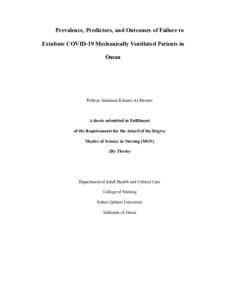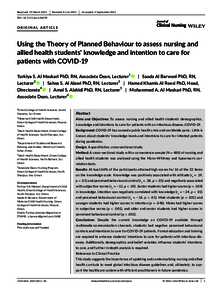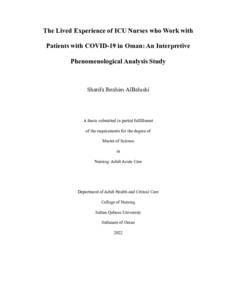Document
Prevalence, predictors, and outcomes of failure to extubate COVID-19 mechanically ventilated patients in Oman.
Source
Master's thesis
Other titles
الانتشار والتنبؤات ونتائج الفشل في نزع أنبوب -19COVID للمرضى الخاضعين للتهوية الميكانيكية في عمان
Country
Oman
City
Muscat
Publisher
Sultan Qaboos University
Gregorian
2023
Language
English
Thesis Type
Master's thesis
English abstract
Introduction: Failure to extubate refers to the inability to sustain spontaneous breathing
after removing an artificial airway within 48 hours of extubation. This is due to severe
respiratory distress caused by COVID-19 infection. The prevalence and predictors of
failure to extubate in COVID-19 patients can vary depending on several factors, including
the severity of the disease, characteristics of the patient population studied, and the specific
criteria used to define extubation failure. Treatment strategies can also significantly
influence outcomes.
Objectives: To assess the prevalence, possible predictors, and outcomes of failure to
extubate adult COVID-19 patients who were admitted to intensive care units in the
Sultanate of Oman.
Methods: This is a multi-center, cross-sectional, retrospective, case-control design study.
Patients (18 years or older) Adult COVID-19 patients who were invasively ventilated and
admitted to ICU in Sultan Qaboos University Hospital and Royal Hospital either
successfully extubated or not from February 2020 to February 2022, were included.
Results: The study included 356 patients. Of 356 patients, 25.6% (n = 91) failed to extubate,
and 74.4% (n = 265) were successfully extubated. Multivariate logistic regression analysis
showed increased odds of failure to extubate risks associated with comorbidities (p
0.001), existing infection (OR = 0.226, 95% CI: 0.126 - 0.408; p 0.001), length of
mechanical ventilation (OR = 0.048, 95% CI: 0.008 – 0.291, p 0.001), antiviral (OR =
0.192, 95% CI .071-0.519; p 0.001). The results also showed that the oxygenation index
significantly predicted failure to extubate invasively ventilated patients with COVID-19
(OR = 0.001, CI = .110 - 0.465, p 0.01).
Conclusions: The prevalence of failure to extubate is 9.74 among adults ICU patients
ventilated invasively with Coronavirus who failed to extubate in this study. The study
demonstrates the importance of early intervention and prediction of failure to extubate
patients with coronavirus ARDS to prevent inpatient mortality and aims for early
intervention and management. All healthcare professionals can use the data provided here
to control and reduce the risk of failure to extubate and prevent complications.
Arabic abstract
المقدمة: يشير الفشل في نزع الانبوب إلى عدم القدرة على الحفاظ على التنفس التلقائي بعد إزالة مجرى الهواء الاصطناعي في غضون 48 ساعة من نزع الانبوب. هذا بسبب الضائقة التنفسية الشديدة التي تسببها عدوى -19.COVIDيمكن أن يختلف انتشار وتنبؤ الفشل في نزع الانبوب في مرضى -19COVID اعتمادًا على عدة عوامل، بما في ذلك شدة المرض وخصائص مجموعة المرضى المدروسة والمعايير المحددة المستخدمة لتحديد فشل نزع الانبوب. يمكن أن تؤثر استراتيجيات العالج أي ًضا بشكل كبير على النتائج. الاهداف: تقييم معدل الانتشار والتنبؤات المحتملة ونتائج الفشل في إخراج مرضى -19COVID البالغين الذين تم إدخالهم إلى وحدات العناية المركزة في سلطنة عمان. الطريقة: هذه دراسة تصميم متعددة المراك، مقطعية، بأثر رجعي، وضبط حالة. تم تضمين المرضى )18 عا ًما أو أكبر( مرضى -19COVID البالغين الذين تم تهويةهم بشكل غازي وتم إدخالهم إلى وحدة العناية المركزة في مستشفى جامعة السلطان قابوس والمستشفى الملكي إما بنجاح أو لم يتم نزع أنبوبهم من فبراير 2020 إلى فبراير .2022 النتائج: شملت الدراسة 356 مريضا. من بين 356 مري ًضا، فشل ٪25.6 )العدد = 91( في نزع الانبوب، وتم نزع الانبوب بنجاح ٪74.4 )العدد = 265(. أظهر تحليل الانحدار اللوجستي متعدد المتغيرات احتمالات متزايدة للفشل في نزع الانبوب من المخاطر المرتبطة بالامراض المصاحبة (0.001> p (، والعدوى الحالية0.226 = OR (، ٪95 0.408 - 0.126 :CI ؛ (0.001> p ، طول التهوية الميكانيكية0.048 = OR (، ٪95 - 0.008 :CI ،0.291 (0.001> p، مضاد للفيروسات0.192 = OR (،) 0.001
Category
Theses and Dissertations



